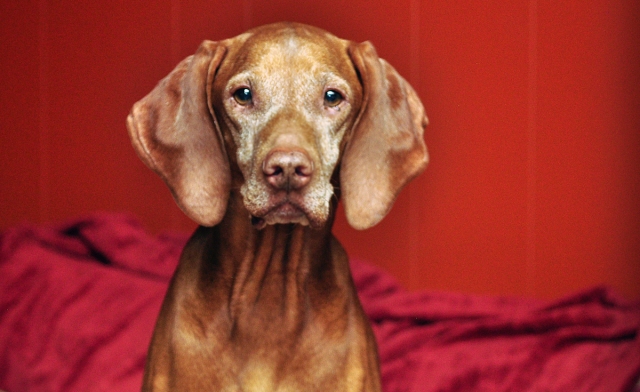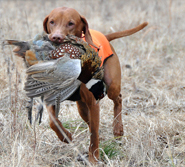Do Vizslas Make Good “Family” Dogs?

This is among the “top 5” questions I get asked by those interested in the breed. Recently, an article on the “best” family dogs made the rounds and for what we understand to be the first time, the Vizsla breed was listed. Many of us with much experience and knowledge about the breed were surprised and concerned. Below are some of the reasons for our surprise and concern:
1. The Vizsla is a highly intelligent breed. This means they are most successful when challenged and given “jobs” (read that as “When given jobs they are less likely to get themselves into trouble and drive you nuts.”). First, they must be given a solid foundation. This foundation includes safe and continued socialization, basic obedience training from EXPERIENCED and KNOWLEDGEABLE trainers (NOT the sessions offered by the local pet stores). An experienced trainer will understand the unique demands of the Vizsla breed and help teach the pup to FOCUS. Teaching a novice trainer how to successfully teach a high drive, intelligent dog to focus is a skill only the very experienced trainers will have. Unfortunately, raising children and “just” being the “family dog” isn’t fulfilling enough for most Vizslas. Because the breed is generally very intelligent, they love to “work” and be given the opportunities to think and learn. So, just as families make the kid’s educational activities a priority, they should also make training their Vizsla a priority. Luckily, there are an interesting variety of games you can play with your dogs these days. Some good ones for the beginner are Rally, Flyball, Canine Good Citizen (CGC), dock diving. If your pups seems to have a good amount of “natural ability” (strong hunting and pointing instincts–talk with your pup’s breeder to gain a solid understanding of the proven hunt throughout the pedigree), get involved with your local Vizsla club and learn about hunting tests. The Junior Hunter title can be a fairly easy title to obtain with the biggest challenge being safe exposure to a starter pistol. For a basic understanding read our post “What are AKC hunting tests and titles for pointing breeds?“. The key here is to find ways to teach your Vizsla to constructively channel her intelligence and desire to work. Botton line, providing mental stimulation is just as important as getting your Vizsla out for safe off leash runs/activities in order to physically tire them.
2. The Vizsla is a HIGH ENERGY breed. Sorry folks, this is a breed that will NOT be satisfied with daily leashed walks around the neighborhood or frequent visits to crowded (and often dangerous) dog parks. This breed was originally developed to hunt on foot (covering a lot of ground) for hours. They are endurance athletes needing daily off leash exercise. This helps them fulfill their desire to work cover and “hunt” (tweety birds and rabbits can just fine work for the adolescent Vizsla!). A family would need to incorporate this regular exercise routine into the family’s overall schedule/activities. Unfortunately, it seems there aren’t many easily accessible, quality places with enough acreage to provide safe, hard off leash runs for sporting dogs. It’s time consuming to just get your Vizsla to a place he can safely exercise, then to walk/run/bike with them takes the motivation of an active person who also enjoys exercising themselves. Oh, and because Vizslas aren’t “self-exercisers” just having a big backyard or several acres isn’t an appropriate solution. Most Vizslas are very strongly bonded to their humans and prefer to be with the family. Unless the family is out enjoying the yard, the Vizsla will want to be where his humans are.
3. Vizslas are prone to developing guarding and separation anxiety behaviors. Because most Vizslas are so needy and love being with their humans as often as possible, they can develop guarding behaviors (thinking their humans are truly “theirs” or the couch they enjoy sharing with their humans is “their” couch). Most people don’t understand or recognize guarding behaviors much less how/why dogs develop them (NO–this has nothing to do with making sure you “dominate” your dog!). Often young couples will add a Vizsla to their home then not put a solid foundation in place. Two or three years later they decide to have a baby and end up with a whole set of problems when their Vizsla isn’t “great with the baby” or growls and snaps at the baby. Vizslas are NOT a “bomb-proof” breed. They require much training and continued socialization throughout their lives but most importantly as puppies, adolescents, and young adults. They need to be safely socialized to human babies and young children and taught to be a well-mannered member of the “pack” (family unit). Separation anxiety often develops when young Vizslas aren’t properly crate trained or taught to be alone for extended periods of time. With regular training, separation anxiety and guarding behaviors can be completely avoided.
4. Vizsla puppies and adolescents require A LOT OF TIME, ATTENTION, PATIENCE. Of the sporting breeds, Vizslas are one of the slowest to mature. This means Vizslas don’t really “settle in” until they’re 3-4 years old. This also means their training must be designed so as to take this prolonged immaturity into account (and not push the Vizsla beyond her capabilities until she grows up/matures more). If you’re interested in a Vizsla to also be a hunting companion, this prolonged immaturity impacts the field training as well. It generally takes a longer period of time to “steady” or “finish” a Vizsla.
5. Vizslas run and play hard which can lead to frequent injuries. Vizslas are a high drive hunting breed. This means most will use their bodies with very little regard when exercising. For a family on a tight budget, a Vizsla can bring financial stress when they get hurt and need costly vet care. This also means the rough-and-tumble-all-out-style of play can injure the humans as well. Children, given their small stature, and the elderly can end up with severe injuries from an enthusiastic Vizsla. We’ve personally witnessed some scary “take-downs” involving Vizslas traveling top-speed and humans who never even saw the hit coming or just couldn’t get out of the way quickly enough. :-/
6. Vizslas can be soft in temperament. This softness, endearing to those of us who love the breed, can lead to frustration for the novice trainer. This softness is also more challenging to train. Vizslas respond well to positive, clicker and treat-based styles of training but still do best under the watchful eye of an experienced trainer (NOT talking about the local pet supply store folks). Please note: We do train our Vizslas to e-collars. We now have a lot of experience in working with Vizslas and e-collars and are absolutely comfortable with this style of training if it’s done correctly. Initially, we worked with experts in e-collar training so as to develop our skills and truly understand this training method.
In addition to the above, I do feel it is so very important to educate families not only interested in the Vizsla breed but in dogs period. Responsible breeders do not add to the problems of pet overpopulation/shelter dogs. Responsible breeders remain in touch with their puppy homes for the life of the dog and will agree to take back or rehome a dog they bred at any point in the dog’s life. It’s the irresponsible people who allow their dogs, pure bred or not, to breed then either dump the dogs and/or litter off at the shelters. Or, they find homes for the pups but then don’t take responsibility for what happens to those pups for the life of the dogs. Do these dogs end up in shelters at some point? Are these dogs eventually bred, thus continuing the vicious cycle? The high-volume of euthanized dogs is also directly related back to high-volume breeders (puppy millers) and “backyard breeders” who sell animals purely for profit. Often, the animals they sell are unhealthy and have been raised in unsanitary, often cruel conditions.
A primary reason dogs are turned into shelters are due to a variety of “behavior” problems. These including biting (usually a human child), house soiling/incontinence, destructive behaviors. Dogs are also dumped at shelters due to “lifestyles changes” (including having children–a couple decides to have children and finds they no longer have the resources such as time energy, and money to care for the dog).
Dogs are not temporary objects to be enjoyed until they are no longer fun or become “inconvenient.” Dogs are not placeholders for human children, to be sent to shelters once the “real” children come along. Dogs are living, breathing, feeling, loving creatures. They deserve to live among a human pack who will care for them as they would one of their own for their entire lives. Of course, legitimate events occur in life when a person has no other choice but to turn their dog into a shelter. This decision though should be made only when all other safe options have been exhausted.
Here are some very good posts anyone considering adding a dog to their family should read first:
1. Who Killed These Dogs? by The Dog Star Daily
2. Why Dogs Bite Children: A Lesson in Preventing Dog Bites in Kids by Victoria Stilwell
3. Why do dogs bite children? by The Dog Star Daily
4. I don’t want a show dog; I just want a pet. by Ruffly Speaking
5. Why Good Dogs end up in Shelters
6. Before You Get Your Puppy by Dr. Ian Dunbar
If, after reading the above you would still like to pursue the idea of adding a Vizsla to your family please ONLY WORK WITH RESPONSIBLE BREEDERS! Read this page, “Interested in a Vizsla? Want a Vizsla puppy? Do it the right way – Get your Vizsla from a RESPONSIBLE BREEDER.” If you decide the Vizsla isn’t the right breed for you, please still use the information provided on responsible breeders or consider a rescue/shelter dog. Please NEVER, EVER buy a puppy from a pet store.
In closing, I’m adding this poem because I found it to be so meaningful:
I adopted your dog today…
The one you left at the pound;
The one you had for ten years
And no longer wanted around.
I adopted your dog today…
Did you know that he’s lost weight?
Did you know he’s scared and depressed
And seems to have lost all faith?
I adopted your dog today…
He had fleas and a little cold;
Guess you don’t care what shape he’s in
— You abandoned him I am told.
I adopted your dog today…
Were you having a baby or moving away?
Did you suddenly develop allergies,
Or was there NO reason he couldn’t stay?
I adopted your dog today…
He doesn’t play or even eat much;
I guess he’s very sad inside and
It’ll take time for him to trust.
I adopted your dog today…
And here he is going to stay;
He’s found his FOREVER home
And a warm bed in which to lay.
I adopted your dog today…
And shall give him all that he will need
— Patience, love, and security,
So he can forget your selfish deed.
Author Unknown
Written by Mel Reveles of FusionVizslas.com. All content is original with the exception of key words/phrases as quoted and credited to the source. I am proud to be a founding member of the Rocky Mountain Vizsla Club– “The Specialty Vizsla Club of Colorado” and a member of the Vizsla Club of America. I am also a participant in the American Kennel Club’s Breeder of Merit Program.
Note: I understand the use of “who” in reference to a dog is grammatically incorrect but I’m just not able to refer to dogs, my beloved companions” as “things”. :-)

